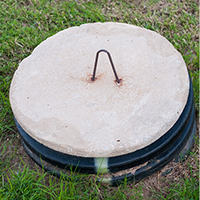Locate your septic tank & drainfield
![]()
How does this action
help our Lagoon?
In Brevard County, failing septic systems contribute as much as 396,000 lbs of excess nitrogen per year to the lagoon—which accounts for about 19% of the overall nitrogen pollutants!* A properly functioning septic system starts with the simple task of understanding where the system components are in your yard—and protecting them.
Once you locate your drainfield, here are a few things you should know:
- Never park or drive on it. It can crush the distribution pipes.
- Only plant grass near it. Roots from trees and shrubbery can clog the drainfield or crack pipes.
Other tips to properly maintain your system:
- Schedule an inspection every 3 years and note it on your calendar. This can prevent costly maintenance, protect the value of your home, and keep your water clean and safe. Earn Lagoon Loyal points for scheduling a septic inspection.
- Keep showers and water usage to a minimum.
- Never flush anything but human waste and toilet paper.
- If you notice bright green, spongy grass and strong odors near your drainfield, call a licensed septic contractor immediately.
Upload a photo of your septic system
location within your yard.
Whether you need to repair your septic tank or have it inspected for maintenance, you will first need to locate the actual drainfield or the septic tank itself.
Here are a few methods to help you find your septic tank and drainfield:
- Look on the “as built” drawing for your home
- Look for a large bump in the grass, set back approximately 5-10 feet from your house (it may only rise one foot or less over your yard)—this is your septic tank. Your drainfield will be an additional 10 feet away.
- Look in your yard for plastic/cement access lids, or a circular PVC cleanout pipe.
- If there are no lids or cleanout pipe, they may be covered by grass. Instead, look for a plumbing vent on your roof—the septic tank should follow a straight line from the house starting at the approximate vent location.
- If all else fails, use an inspector/plumber, who can help you find exactly where the system is located and determine if it needs septic tank pumping or residential septic tank cleaning.
Be sure to capture the access lid of your septic tank in your photo.

















